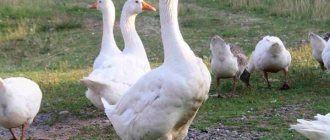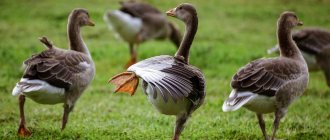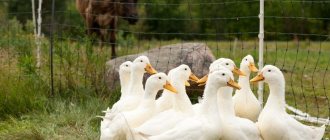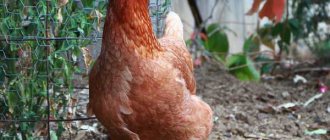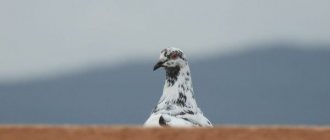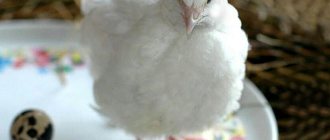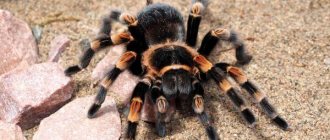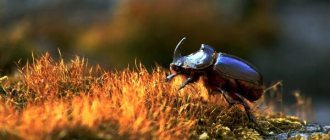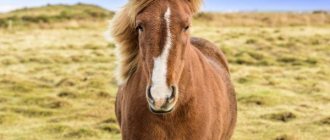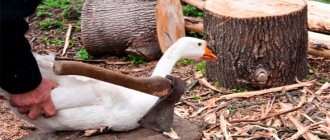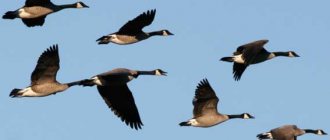Representatives of the breed are medium in size with a slightly elongated body. The rather long neck with a strong bend resembles the neck of swans. On the large head there is a beak with a growth.
In the white species it is colored orange, and in the gray species it is black. Over the years, the growth increases in size.
Wings with a large span, fitting well to the body. The bird moves on widely spaced, strong legs, colored orange. The tail is raised up.
Males are larger than females in size, and they also differ in the size of the cone. Weight varies from 5 to 6 kg, and geese live 20–25 years.
Character
Birds are very energetic, and aggression towards people and animals is the norm. They show the greatest aggression during the period of egg laying. Chinese geese do not get along with other birds, and therefore they are housed separately.
They are very loud because they love to show their voice.
Maternal instinct
In geese, the maternal instinct and the brooding instinct are poorly developed. Adult birds - geese and ganders, often, not recognizing the brood, do not protect it from predators and dangers. The farmer has to take care of the safety of the goslings himself.
Egg production
Geese are precocious, and already at the age of 9 months they begin to lay eggs. The duration of egg production is 6 months. The average is 50 to 80 eggs per year.
The maximum number of eggs that was recorded was 120. One egg weighs about 150–160 g.
It is impossible not to note the high hatchability rate, which reaches 85%. The young grow quickly and gain weight. By 3 months their weight is 3.5 kg.
The instinct to hatch in females is poorly developed, so most often the eggs are placed in an incubator.
Varieties
Initially, Large gray geese were bred at a Ukrainian breeding farm. With the beginning of the Great Patriotic War, the livestock was transported to the Tambov region, where work with poultry continued. It was on the Arzhenka farm that representatives of the breed were raised on free grazing.
Ural, or Shadrinsky
The Shadrinsk bird has external features similar to the description of the Large gray breed of geese: a dense muscular body, a short neck, strong legs. The weight of males reaches 7 kg, females weigh no more than 5 kg. Unlike its Ukrainian counterparts, the Ural bird is more squat and has a thick neck. There are three more subspecies in the breed, distinguishable by feather color: white, actually gray and checkerboard (variegated).
The bird is attractive for breeding in a private backyard due to the following qualities:
- good health and unpretentiousness to living conditions;
- rapid growth of young animals;
- developed parental instinct (even ganders are capable of lovingly caring for their offspring).
Individuals are perfectly adapted to the harsh climate of the Urals and do not require heated premises for wintering. An ordinary wooden shed and deep straw bedding is enough for them.
Young animals are well fed on natural pastures and are ready for slaughter at 7–8 months.
Ukrainian, or Borkovsky
These are the founders of the breed. For breeding, crossing Toulouse geese with Romny males was used. Then the resulting offspring were bred “inside”.
Ukrainian geese are large, the weight of ganders can reach 10 kg, and females - 6.5 kg. It is impossible to gain such weight only by grazing, so the bird must be given grain: oats, barley, wheat.
The egg production of Borkovsky geese is 50–60 eggs per year (females show maximum egg production in the 3rd–4th year of life), for 2 clutches.
Tambov, or steppe
In the selection of gray geese of this type, emphasis was placed on adaptability to pasture keeping. Due to the lack of water bodies in the vicinity of the farm, the birds grazed on dry pastures and were content only with drinking water.
Steppe geese are somewhat smaller than their Ukrainian relatives, but are extremely unpretentious. They successfully fatten on almost nothing but grass and carefully raise their goslings.
Kinds
Geese may vary in plumage color.
White
The Chinese white goose was developed by crossing the knucklehead goose with representatives of Indian breeds. This variety was widespread throughout the USSR.
Farmers fell in love with it because of its ease of care and good hatchability. The variety differs from other individuals exclusively in its lighter color. Geese begin to lay eggs earlier than their relatives, but in the same quantities.
Grey
The gray breed spread more slowly. It is popular among breeders. They crossbreed Chinese Grays with other species to improve meat quality and egg production.
The goose's plumage is gray-brown in color. A pale stripe runs from the head along the body, it is called a belt. In terms of performance, gray geese lag behind white geese: per year they lay 50–70 eggs weighing 120–130 g.
Description of the breed
Many centuries ago, the cone-nosed goose was domesticated by the inhabitants of Manchuria. Only in the 18th century did it come to Europe and Russia and took root like the Chinese goose.
The breed is represented by two types: white and gray . Goose meat is an expensive product. But since their average weight is up to 5 kg, these geese are raised for meat less often than others.
The egg production of geese deserves special attention . From one individual, 75 - 85 eggs are obtained per season, while in heavy industrial breeds the egg production rate rarely exceeds 40 eggs. Appearance
Chinese geese are representatives of a noble breed with a slender build and an elongated neck, like a swan. The voice is trumpeting. Torso
Elongated body, with broad shoulders. The stomach is taut.
Back
The upper part is convex, with a sharp drop towards the tail.
Breast
Round, proudly raised.
Tail
Steeply raised, small in size.
Wings
They have a wide span and are well pressed to the body.
Stomach
Dense texture, smooth, does not droop.
Head
The elongated shape ends in a semicircular cone, which is a feature of the breed.
All listed body characteristics refer to a male .
The female is smaller and has a small bump on her forehead.
Maintenance and care
Chinese geese are extremely unpretentious birds. Therefore, for a beginner in poultry farming, this is the best option.
First of all, there are several aspects to consider:
- birds should be kept in a spacious, warm, dry place;
- it is necessary to protect birds from drafts;
- Geese need 24-hour access to feeders with food and water;
- be sure to establish a good ventilation system;
- Clean the house and bowls weekly.
As a rule, birds are not walked during the cold season. To keep the birds warm, it is necessary to build a poultry house.
Large gray
In the 50s of the last century, a new breed of geese was created - large gray ones, which are generally considered to be of Ukrainian origin - Borkovsky, Russian - Steppe Tambov. The birds belong to the category of medium-heavy birds, have a wide body, a well-defined belly, powerful pectorals, slightly convex muscles, a compact head, and a powerful beak of an orange-red hue. Geese have gray, dark gray plumage with white coloring on the belly.
The breed is characterized by the following advantages:
- good egg-laying indicators: in one season, a goose can lay up to 60 eggs weighing up to 175 g, while the viability of the clutch reaches up to 70%;
- rapid weight gain. By 9 weeks the bird’s weight reaches 9.5 kg;
- endurance, active character;
- the ability to do without bodies of water;
- low dietary requirements.
The disadvantage of this breed is the relatively low survival rate of young animals, about 60%. In addition, gray geese are vindictive, remember the offender for a long time and can even take revenge after a certain time.
Since ancient times, goose fat has been on the list of useful products that are used in folk medicine to treat respiratory diseases.
Poultry house
The premises must meet certain conditions:
- The height of the building must be at least 2 m. The area depends on the number of individuals. The standard calculation is 2 m2 per individual.
- The temperature in the poultry house should be fixed at no higher than 20° ; it is at this level that the bird feels good. During the fattening period, the temperature is lowered to 15° in order to increase appetite.
- A hygrometer should be installed in the room to measure the humidity level. For geese, a value of no more than 80% is suitable. To get rid of high humidity, it is advisable to build in good ventilation.
- to allow natural light to enter . The duration of daylight hours for adults is 14 hours.
- Bedding must be placed on the floor in a layer of approximately 40–60 cm. Typically, hay, shavings or sawdust are used for this. With gradual contamination, it is worth replacing the bedding layer.
- In winter, you can insulate the bird house with anything, at least there should be no gaps.
- Floors should always be dry and warm. A wet floor makes the bird vulnerable to a wide range of diseases, as wet feathers do not retain heat.
- Feeders are divided into 2 types. The first is for dry food, and the second is for river sand, which birds periodically consume. Feeders are located at a distance of 15–20 cm from the floor.
- There should always be fresh, clean water in drinking bowls. In winter, it is advisable to heat water containers.
- Place the nests in the house. One nest can carry from 2 to 4 females.
Pairing
Mating is carried out in several ways. Farmers often practice natural mating, but there are situations when breeders need to get a specific breed and bring together the individuals they need, then they resort to forced mating.
It is best to use natural reproduction, because the children who choose each other grow faster and are stronger.
In natural mating, individuals live together in the same area. During the period of sexual hunting, males and females gradually take a closer look at each other. Only when reciprocity appears between the birds do the pairs retire to breed.
When making your own selection, you should pay attention to females and males of approximately similar build: individuals that are too thin or fat will not produce the desired offspring. Sometimes mating does not occur at all: the goose does not want to breed with such a female, sometimes even shows aggression
In general, breeding the Italian breed of geese is not a difficult matter; it does not require compliance with any mandatory conditions, as happens with other birds.
There are 3 females per goose. For them, a special section with three nests is equipped in the room. The house must have enough space for all individuals, so a house of appropriate size should be built. This breed behaves calmly when mating and provides proper care for future offspring.
After birth, the chicks grow very quickly and rapidly gain weight. By the 9th week of life they reach 3-4 kg, their meat is of excellent quality. The costs of Italian geese are fully justified by the quality of the final product.
Walking in nature
For rapid development, wonderful well-being and high performance, birds should be released for a walk in a specially equipped place. The passage that leads to the equipped site is usually located on the southeast or south side.
The height of the fence, usually a mesh, must be at least 1.5 meters so that the birds cannot fly out. A canopy is installed at the walking area to provide shelter for the birds from the scorching rays of the sun or from pouring rain, as well as drinking bowls and feeders.
Before the cold weather begins, it is better to walk birds on pastures. This way they will gain more fat and survive the winter easier. Due to grazing, significant feed savings occur.
If possible, provide birds with access to a pond. There they can find many useful substances.
Swimming improves the health of Chinese geese.
Italian
The bird was bred in the vastness of Italy, currently the most popular breed of geese in the whole world, the fact is that geese have a delicious taste of meat and fatty liver, from which foie gras is prepared. In addition, the birds have a beautiful appearance, body size and shape, neck length, wings and tail, everything is in harmony with each other. The snow-white plumage adds special beauty to the bird.
Advantages of the breed
- – adapt well to poor climatic conditions;
- – it is possible to keep it without walking near water bodies;
- – egg laying is 40-50 eggs, weighing up to 170 grams, hatchability is about 70%;
- – have a strong and strong-willed disposition, do not mix with geese of other breeds;
- – at two months the bird’s weight reaches 4 kg;
- – productive age lasts up to 5 years.
Nutrition
Geese are not very demanding when it comes to nutrition. So, in the summer, birds are fed once: in the evening. During the warm period, birds themselves can find food, for example, when they are on pasture.
It's good if you feed your pets at the same time, then they will get used to it and will know when to come back. In winter, birds are fed 2 times a day: in the morning and in the evening, and the morning meal is smaller than the evening meal.
Chinese geese are very fond of sorrel, dandelion, plantain, clover and cattail. In reservoirs they often find reeds. You cannot feed only dry food, it should be alternated with natural products, otherwise it can lead to intestinal problems.
Very often, birds are fed mixtures of crushed root vegetables.
For dinner, poultry farmers usually provide concentrated feed such as bran, oats, wheat or barley. For faster digestion, add chalk, sand or even gravel to the food. You can also add vitamin and mineral complexes.
Diet for 1 individual per day:
- fresh vegetables and root vegetables – 600 g;
- feed – 700 g;
- concentrates – 150 g;
- mineral supplements – 30 g.
Sometimes during the breeding period, geese are transferred to three meals a day. Particular attention is paid to ganders. They need additional feeding to feel better. Geese eat first exclusively.
Adding pine needles to your diet is very beneficial. It improves appetite, increases egg production and fills the body with all vitamins. First they are dried, and then the needles are ground.
The nutritional standards and diet for goslings are completely different. As soon as the chick has dried, it should be fed immediately. A good option would be a crushed egg with corn grits. Meat and cottage cheese are gradually introduced over a couple of weeks.
Potatoes with sprouts should not be included in the diet, as sprouts contain a substance that has a detrimental effect on the body.
Feeding
The diet of geese is somewhat different from the diet of other poultry. Geese have the ability to gain weight without eating grain feed - it is usually used as a supplement to greens.
Diet
The main ingredient in the diet of Chinese geese is greens. If a bird regularly grazes on a walk and feeds in a pond, then they grow strong and healthy. But in winter the bird will need additional food.
What do they feed Chinese geese:
- In winter, the following is introduced into the diet of geese:
- mash - they are steamed from potatoes, carrots, beets;
- whole grains – wheat, barley, oats;
- mineral and vitamin components - they are mixed into the feed;
- fish and bone meal;
- salt and chalk.
- Chinese geese must be given root vegetables, garden tops, grain mixtures with bone meal, and vitamin and mineral supplements.
- In summer, geese eat plant foods; they like plantain, clover, yarrow, dandelion and other plants. In a pond, they happily eat cattails and reeds.
- Geese should get plenty of water. The bird can drink up to 2 liters per day. Water deficiency leads to a critical drop in egg production, which is difficult to recover.
Feeding standards
In summer, the bird grazes on the range, eating food as needed. In winter, geese are fed 2 times a day - at the same time. Feeding standards for adult Chinese breed geese are in Table 2.
table 2
| Feed | Weight, g |
| Carrot | 100 |
| Boiled potatoes | 100 |
| Cabbage | 50 |
| Grain mixture | 50 |
| Salt | 0,5 |
| Chalk | 5 |
Recommended feeding regimen for two meals a day:
- in the morning - mash;
- at night – grains.
Breeding
The high level of egg production attracts many farmers. It is worth considering that the brooding instinct of geese is almost undeveloped, so the eggs are placed in an incubator.
Geese are also very popular among breeders; breeds with better characteristics are being bred.
First generation hybrids of the Winxi breed:
- Kholmogory x Chinese lays 60 eggs per season;
- Pereyaslavskaya x Chinese produces 50 eggs per season;
- Lindovskaya - 50 eggs;
- Italian – 70 eggs.
Natural hatching
The goose, ready to lay, behaves restlessly.
Features of natural hatching:
- Females lay on their eggs between February and May, usually around the beginning of April.
- One goose hatches up to 13 eggs; it is difficult for her to heat more.
- The nest is located away from the herd; it should be dry and quiet, the temperature should be 15°C.
- If there are several hens at once, they are separated from each other by partitions.
- The hens are fed the best grain.
- Hatching duration is 28-30 days.
After the specified period, the eggs are placed in a box and illuminated with a lamp. When the chicks begin to hatch, they are returned to the goose. The best option is to leave the goslings with the goose. If this does not work, the chicks are placed in a separate enclosure, warm and dry.
If one of the eggs breaks during incubation, it is removed from the nest and the remaining eggs are wiped out.
It happens that a goose, having left the nest, does not return for more than 20 minutes, in this case it is forced to return - probably its brooding instinct is poorly developed.
Through the incubator
If the maternal instinct is insufficient, when the geese refuse to incubate the eggs, it is necessary to use an artificial method of breeding chicks.
To artificially breed goslings you will need:
- incubator;
- A brooder is a device for heating chicks;
- ovoscope - a device for candling eggs.
A good hatching result for an incubator is 70%, but it can be higher.
Incubation stages:
- They take away the eggs. The maximum “age” of eggs is 10 days. Choose smooth, healthy-looking ones; the shape should be ideal. They are not washed, only sprinkled with potassium permanganate to kill germs.
- 4 hours before laying the eggs, the incubator is heated to 39°C. Humidity is maintained at 60-65%.
- The eggs are placed in the incubator and the temperature is set to 38°C for 4-5 hours. Then it is reduced to 37.8°C, and 2 days before removing the eggs from the incubator, the temperature is lowered to 37.5°C.
- If the incubator does not have automatic turning, eggs are turned manually up to 8 times a day to ensure even heating.
- 15 days after the start of the process, the incubator is periodically ventilated. Ventilation time – 10 minutes.
- On days 11 and 27, the eggs are inspected; if there is no embryo stain, they are discarded. If during the 2nd inspection a solid dark clot is visible, the embryo is dead.
Features
Chinese geese have distinctive features compared to European breeds. This is the presence of a bump on the forehead, closer to the base of the cranberry. The color of the plumage can be white or gray, depending on the species. Nutrition of adult geese
Chinese geese do not have a large live weight; they are not picky about feeding conditions. In the summer, geese take care of themselves and find healthy food in the pastures. Geese love yarrow, plantain, clover, nettle, sorrel, alfalfa, and dandelions. When entering a body of water, they look for chastukha, nasturtium, reeds, and cattails. At home they feed only in the evening. Geese accustomed to this way of feeding will always return to roost.
For dinner, the bird should receive concentrated feed:
oats barley wheat bran cake
To improve digestion, use supplements:
- shell rock;
- sand;
- gravel;
- chalk.
A combination of wet and dry food will help balance minerals and protein. Drinking water should be abundant.
If geese are kept in a pen, then one individual per day should receive in grams:
- herbal flour - 300;
- vegetables and root crops – 500;
- green feed - 700. concentrates 120
In winter, geese are fed two meals a day, preferably at the same time. On the eve of the breeding season, switch the geese to three meals a day.
During the breeding period, pay special attention to ganders. They require additional feeding so that the fertility of eggs does not decrease.
The ganders eat after the females, when the nutritional mixtures remain in small quantities. It is enough to prepare individual hanging feeders for them at a height of 30 cm from the ground.
Roughage in combination with juicy root vegetables is introduced into the diet. Beets and carrots are added raw. Before serving, you need to chop them well.
Silage is a good product for replenishing the body with carotene, vitamins, acids, and carbohydrates.
Pine and spruce needles improve appetite, increase egg production, and enrich the body with vitamin C. The branches are prepared in advance. They are dried, needles are collected and ground in a meat grinder.
Hay and rot are a source of fiber.
They improve the taste of food using yeast. Dissolve 20 g of yeast in two liters of warm water and add 1 kg of grain. Sprouted grain has a good effect on the reproductive function of geese. They prepare it like this: take good, full-weight grain, wash it in hot water, spread the loan on damp burlap in a 1 cm layer, cover it again with burlap on top, and make sure that the grain is wet all the time. After two days, the grain begins to produce the first white root, at this time it contains a lot of vitamins and amino acids, such grain is fed in the amount of 50% of the total concentrated feed per day.
Wheat, oats, barley, alfalfa, clover are required ingredients before egg laying. How much feed you need to increase can be seen from the diet table for adult geese, the norm per head per day.
Remember that young geese starting laying for the first time should be fed with an increase in the norm by 30%. since they have not yet completely finished growing.
| Name of feed quantity per g | Geese during the resting period | Preparing for egg laying | Intensive egg laying | Reproduction completion period |
| Grain mixture including sprouted grain | 100 | 120 | 160 | 130 |
| VTM1 | 150 | 180 | 300 | 120 |
| Carrot | 150 | 230 | 300 | 150 |
| Animal feed of 2 origins | 50 | 150 | 200 | 100 |
| Potato | 200 | 250 | 250 | 200 |
1 Vitamin-herbal meal from alfalfa 2 Cottage cheese, minced meat, meat and bone and fish meal, milk, curdled milk.
Offspring
Goslings need proper care from the first days of life - at this time their immunity is formed and further development depends.
Conditions for keeping goslings
The enclosure where the goslings are kept is kept warm, dry and clean. Conditions of detention:
- Temperature. In the room where the brood is located, the temperature is maintained at 28-30°C. If the goslings are uncomfortable, they become less active:
- when overheated, the chicks open their beaks and drink frequently;
- Having frozen, the goslings huddle together and practically do not eat.
- Humidity. Should not exceed 75%. With excessive dampness, the incidence of disease in livestock increases. The situation is aggravated by infrequent replacement of bedding and poor ventilation.
- Ventilation. It is necessary from the first days of life of the goslings. In the warm season, round-the-clock ventilation is desirable.
- Litter. Thickness – 3-5 cm. Update – every other day.
- Lighting. For the first 7 days, the chicks’ home should be illuminated around the clock - the development, health and rate of weight gain of the goslings depend on the length of daylight hours. But there should still be a separation between day and night - at night the light is dimmed. After a week, daylight hours are reduced to 16-17 hours. They do this gradually, shortening the “day” by 30-40 minutes every day.
From the moment of hatching to the full plumage of the goslings – 75-80 days.
Feeding the goslings
Geese need a balanced diet - then the birds will grow large and healthy.
At each moment of time - your own diet:
- The first 5-7 days give the yolks of boiled eggs. They add greens - finely chopped onion feathers. For the first 2 days, goslings are fed 7-8 times a day.
- Various herbs are gradually introduced into the diet - in addition to onions, the goslings are fed clover and alfalfa. You can’t give a lot of greens at once.
- After 10 days, fattening compound feed or mash is given. The first mashes are made from eggs, crushed corn, wheat and barley, and a little semolina is added to make it crumbly. Tricalcium phosphate is added to the mash - it prevents “falling on your feet.”
- After 5 days, instead of eggs, cottage cheese, crushed boiled potatoes, sunflower cake and greens are added to the mash.
Vitamins “Tetravit” and “Chiktonik” are introduced into the diet of goslings. They are added to water. Feeders with fine gravel or crushed shells are placed in the access area. Sand is not given to young animals.
20 minutes after feeding, the remains of the mash are removed so that the perishable components do not begin to decompose and lead to poisoning of the chicks.
Number of meals
In the first hours of life, chicks should not be overfed, since they still have natural yolk in their stomach. Complementary foods are introduced gradually.
With constant walking and natural feeding, Italian geese can be fed with special food only once a day - in the evening. They will get the rest on their own during walks.
With limited or no grazing, it is worth considering that these geese can feed at any time of the day, even at night. Therefore, it is advisable to have food in the feeders around the clock. Perishable products, especially milk, must be disposed of after 1-2 hours.
There should always be drinking water in the drinking bowls, the freshness of which must be constantly monitored. In hot weather, liquid is added more often than in winter. The water in which the potatoes were boiled cannot be used. Solanine remains in it - a toxic substance contained in this root vegetable.
You will find more information about preparing a diet in the article “What to feed geese from the first days of life at home.”
Advantages and disadvantages
The Chinese goose has many advantages:
- precocity;
- high egg production;
- ease of care;
- good survival rate;
- excellent quality meat.
Unfortunately, there are also disadvantages:
- undeveloped brooding instinct;
- excessive aggression.
Origin
This breed has different ancestors, unlike the rest of the majority of geese. They originated from the sukhonos. Drybills are waterfowl, representatives of the Anatidae, which lived in China. Later, the inhabitants of Manchuria were able to domesticate birds. It was after this that their popularity began to grow, and the birds began to rapidly spread throughout the country.
In the 7th century, the Chinese brought geese to Russia. Russian breeders began to breed various breeds. For example, Kuban or Gorky.
Geese have gained popularity due to their high egg production.
Diseases and prevention
Chinese geese are resistant to diseases and rarely get sick, especially if the conditions of detention are not violated.
Main measures to prevent diseases:
- maintaining cleanliness in the poultry house;
- routine vaccination;
- compliance with area standards.
Before placing young animals in a poultry house, they must be disinfected. The poultry house is also treated:
- the walls are whitewashed;
- the litter is changed;
- goslings are given a weak solution of potassium permanganate and glucose (on the second day of life) - to strengthen the immune system;
- To prevent salmonellosis, the drug "Tilan" is given.
Geese suffer from infectious diseases - viral enteritis, salmonellosis, and non-infectious ones. The former are associated with violations of sanitary standards, the latter are usually provoked by violations of the rules of housing and feeding.
White Chinese
White geese from China appeared as a result of domestication of the wild swan goose (otherwise called the knobby Chinese goose) in the process of crossing with gray and Indian goose representatives.
White Chinese have been getting divorced in Russia for quite a long time, having begun their domestic history back in the former USSR.
The appearance of the white Chinese goose matches the general description of the breed as a whole:
- swan neck,
- a noticeable bump on the frontal part of the head.
The white goose differs from other representatives only in the color of its plumage. Its beak, frontal bump, metatarsals and paws are painted bright orange.
Farmers fell in love with the white breed for its unpretentiousness in maintenance and care, noting very good rates of hereditary reproduction, reaching 70-80%. Newborn goslings have high vitality, up to 99%.
White birds from China gain body weight between 4.0 and 5.5 kg, with nine-week-old goslings weighing about 3.0 kg. White geese begin to lay eggs at the age of 270 days. Typically, goose egg laying begins in December and continues for 6 months. White Chinese geese lay up to 70 eggs per laying, with an average weight of 150 g each.
Farmers note that white Chinese geese often have an aggressive character.
